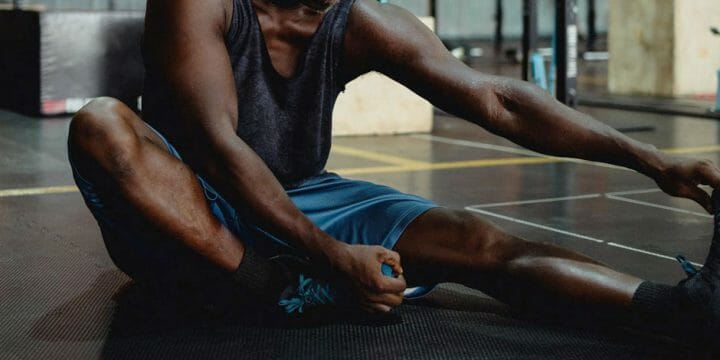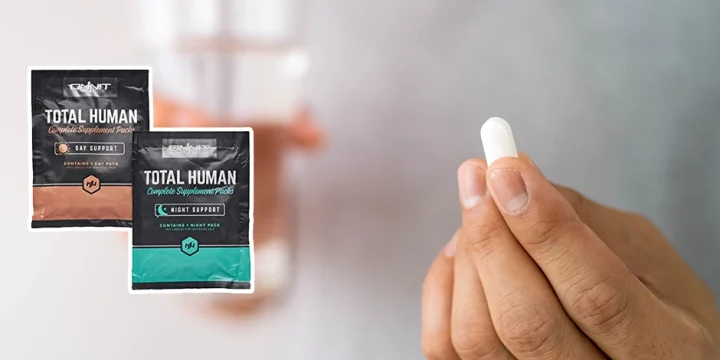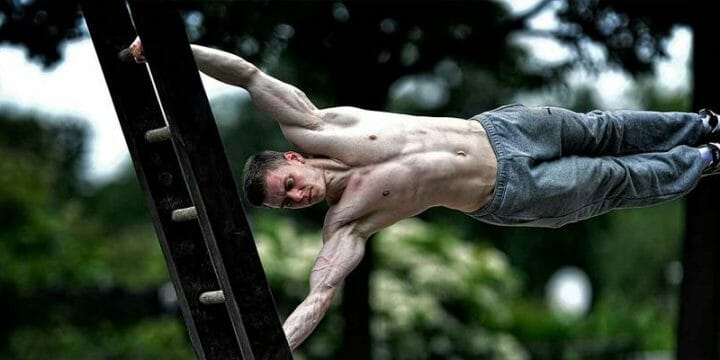As a fitness trainer, I understand the importance of targeting and strengthening specific muscle groups for overall health and performance.
The vastus lateralis, one of the four quadriceps muscles, plays a vital role in knee extension and stability.
This article will explore practical exercises designed to target and develop your vastus lateralis, providing improved leg strength, balance, and injury prevention.
Let’s dive in.
Quick Summary
- The best exercises to work the vastus lateralis muscles include squats, lunges, extensions, and presses.
- The vastus lateralis works in conjunction with other quadriceps muscles, like the rectus femoris, for knee extension.
- A review of studies from ScienceDirect suggests that osteoarthritis, diabetes mellitus, and cardiovascular disease are associated with lower leg power compared to older adults without these conditions.
- The vastus lateralis contributes significantly to the size of the upper legs.
Best Vastus Lateralis Exercises

Before we look at the best exercises to strengthen the vastus lateralis, let’s look at precisely what this muscle is.
What Is the Vastus Lateralis Muscle?
The vastus lateralis muscle is the largest of the four quadriceps muscles and sits on the outer thigh. It originates from your thigh bone and attaches to the side of your knee cap [1].
The vastus lateralis works with other quad muscles like the vastus medialis, intermedius, and rectus femoris, particularly for knee extension.
What Is The Outer Quad Sweep?
Outer quad sweep is a term used to describe the vastus lateralis muscle on the outer thigh. Having a curved and defined quad can significantly enhance the appearance of the lower body musculature.
Let’s examine what exercises can give you the desired quad outer sweep.
1. Leg Extensions
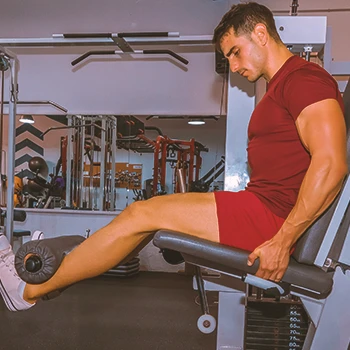
Pointing your toes inward during this leg extension exercise emphasizes the vastus lateralis muscle.
Here’s how you do them:
- Sit on a leg extension machine and position the pad over your ankles.
- Make sure to point your toes inward.
- Completely extend your legs at the knees.
- Slowly lower back to the starting position.
- Repeat for the desired number of reps.
2. Narrow-Stance Leg Press
With this exercise, you’ll bring your feet closer together in the narrow or close-stance leg press than with a traditional weighted leg press, effectively working the outer quads.
Placing your toes higher on the platform for the entirety of the movement will really activate the vastus lateralis muscle.
Here’s how to do it:
- Sit on the leg press machine and position your feet less than shoulder-width apart.
- Have your toes slightly pointed out.
- Lower the safety bars and press the platform up until your legs are fully extended in front of you.
- Inhale and slowly lower the platform until the upper and lower legs form a 90-degree angle.
- Exhale and slowly push with the heels of your feet to get back to start.
- Repeat for the desired reps.
3. Dumbbell Lunges
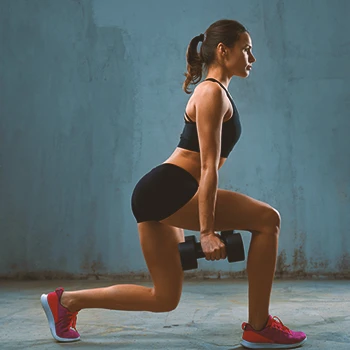
Dumbbell lunges, a staple in the best dumbbell leg exercises, are a compound exercise that targets all the quad muscles, including the vastus medialis and lateralis. Keep your head up and your back straight throughout the movement.
Here’s how to do them:
- Hold dumbbells in a neutral grip with both hands.
- The feet should be hip-width apart while standing.
- Step forward with one leg, bending the front knee and lowering until both knees are at a 90-degree angle, the back knee just above the ground.
- Push off the heel of the front foot to return to the starting position.
- Switch legs and repeat for desired reps.
“Strengthening and toning your quads can help improve the stability of your knee, reduce your risk of knee injuries, improve your athletic performance, and make everyday movements easier to do.”
- Daniel Yetman, BSc Kinesiology
4. Machine Hack Squats
The machine hack squat is a variation of the squat that is great for building leg muscles such as the quads, hamstrings, glutes, and calves.
Here’s how to do them:
- Use a hack squat machine.
- Position feet hip-width apart.
- Release safety handles and slowly lower until knees are at 90 degrees.
- Push through heels to get back to the starting position.
- Repeat for desired reps.
5. Sissy Squat
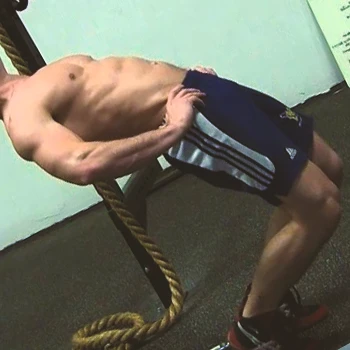
Sissy squats are one of my favorite quad-focused exercises. They primarily work the quads and hip flexors while strengthening the core muscles and improving balance.
Here’s how to do them:
- Here’s how to do the sissy squat:
- Stand with feet shoulder-width apart.
- Raise up onto your toes, pointing forward, and use a prop for stability.
- Bend at the knees and tilt your body backward, squatting as far as you can without losing balance.
- Hold at the bottom for up to 3 seconds.
- Push back up to the starting position through the balls of your feet.
- Repeat for desired reps.
6. Front Squat
Front squats, a key component of front squat fundamentals, are a classic exercise for building muscle mass in the lower body.
I recommend these to clients who have a tough time getting full depth on the back squat, as holding the barbell in the front squat helps shift more weight in front of you, helping you achieve more depth on the squat.
Here’s how to do front squats:
- Grab a bar with palms facing away and rest it on the upper chest.
- Stand with feet hip-width apart and engage the core.
- Lower into a squat position until your thighs are parallel to the floor.
- Push up through heels to return to the starting position.
- Repeat for desired reps.
7. Dumbbell Bulgarian Split Squat
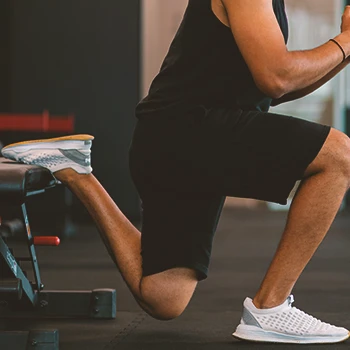
The Bulgarian split squat works several muscles, including the quads, glutes, hamstrings, abdominal muscles, and erectors in your back.
Here’s how to do them:
- Stand in front of a sturdy bench or chair with your core engaged, shoulders back, chest open, and eyes straight ahead.
- Place your right foot on the bench behind you, either at the ankle joint or ball of the foot.
- Your feet should be roughly hip distance apart; the back foot is for balance only.
- Engage the core with the chest high and eyes forward; bend the left knee while allowing the right side to naturally bend, keeping the load balanced across the left foot.
- Hinge slightly forward at hips, ensuring alignment of left knee and toes.
- Inhale through the downward phase until the left quad is parallel to the ground; exhale by pressing back to standing using the left quad and glute power.
- Step off the bench after completing one side, then repeat the process on the other side.
What Happens If You Have a Tight Vastus Lateralis?

If you have a tight vastus lateralis, it can lead to knee problems and discomfort during everyday activities. Prolonged sitting or intense workouts can lead to a tightening of this muscle.
Muscle strain can also result in vastus lateralis pain, characterized by tenderness, sharp pain, and snapping/popping feelings if the muscle tears.
If you experience a vastus lateralis strain, you should seek advice from a medical professional, but common practice is to follow the RICE protocol: rest, ice, compression, and elevation [2].
To avoid vastus lateralis pain, be sure to:
- Warm up before exercise.
- Stretch after exercise.
- Implement a consistent strength training routine.
- Stretch regularly to improve flexibility.
What To Do For Tightness

You can do several things if you are experiencing tight vastus lateralis muscles.
First, here are some effective stretching exercises.
1. Kneeling Quad Stretch
For a deeper, more challenging stretch, tilt your pelvis back and keep your chest upright as you lean your hip forward.
Here’s how to do it:
- Kneel on your left knee at 90 degrees with your left foot behind you.
- Grab your foot and push away from the center of your body.
- Drive your hips forward and lean forward, keeping your back straight.
- Hold for 15–30 seconds, then repeat with the other leg.
- Do 3–5 times for each leg.
“There shouldn’t be any tearing damage in a stretch, no injury,”
- Dr Alice Holland
2. Side Lying Quad Stretch
Here’s how to do it:
- Lie on your left side.
- Bend your right knee and move your foot behind you.
- Reach back to grab the right foot, then gently pull it towards you while pushing your hips forward.
- Remain in this position for 15–30 seconds.
- Lie on your right side and repeat with the left leg.
3. Hero Pose Stretch
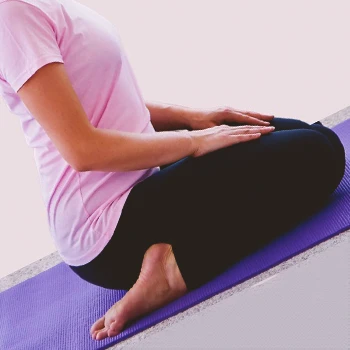
Here’s how to do it:
- Kneel on the ground with knees together and feet separated, toes facing in.
- Sit back in the area between your feet and lean back slightly.
- Use your arms to brace yourself.
- Maintain the position for 30–60 seconds.
- Gradually transition back to the start.
4. Standing Quad Stretch
Here’s how to do it:
- From a standing position, position your feet hip-width apart.
- Reach behind the body and grab one foot.
- Bring your foot up behind the glutes.
- Gently pull and hold for 30–60 seconds.
- Repeat with the other leg.
5. Trigger Point Release
Before performing the stretches listed above, give this trigger point release a try.
Here’s how to do it:
- Lie face down on the ground with a massage ball/foam roller positioned above the knee.
- Move the body into a side plank position to apply pressure and find painful spots.
- Rock back and forth over sore spots for 1–2 minutes.
- Repeat 2–3 times, followed by stretching.
Benefits of Strong Leg Muscles
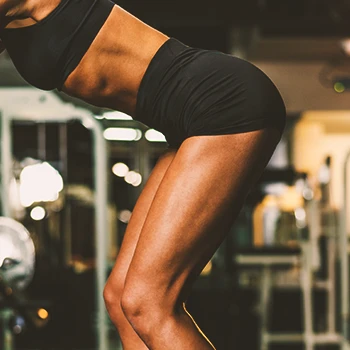
Strengthening and stretching the leg muscles, particularly the vastus lateralis, has many advantages.
These include:
- Preventing bone and joint ailments: A review of studies from ScienceDirect suggests that osteoarthritis, diabetes mellitus, and cardiovascular disease are associated with lower leg power compared to older adults without these conditions [3].
- Increased strength in leisurely athletic activities: Stronger legs mean carryover strength to fun activities like hiking, jogging, biking, and playing your favorite sports [4].
- Increased testosterone levels: Studies show that resistance training can lead to increased T levels [5]. With your quads being the second largest muscle, this means more muscle activation and higher T levels.
FAQs
What Happens If You Have a Weak Vastus Lateralis?
If you have a weak vastus lateralis, it can affect the function of the other thigh muscles, which can further affect mobility and walking and increase the risk of muscle strain and injury.
Is the Vastus Lateralis a Hip Flexor?
Yes, the vastus lateralis is a hip flexor and knee extender belonging to the quadriceps femoris group, which also includes the vastus intermedius, medialis, and rectus femoris muscle.
References:
- https://www.ncbi.nlm.nih.gov/books/NBK532309/
- https://www.ncbi.nlm.nih.gov/pmc/articles/PMC2941577/
- https://www.sciencedirect.com/science/article/pii/S1279770723014240?via%3Dihub
- https://www.health.harvard.edu/blog/strong-legs-help-power-summer-activities-hiking-biking-swimming-and-more-202205122743
- https://www.ncbi.nlm.nih.gov/pmc/articles/PMC7739287/
About The Author
You May Also Like
